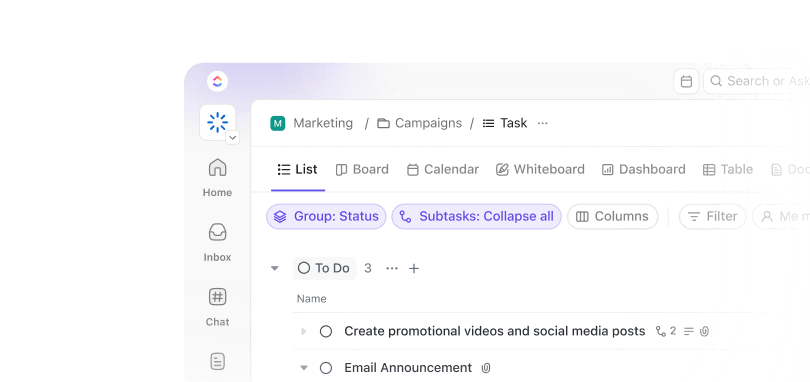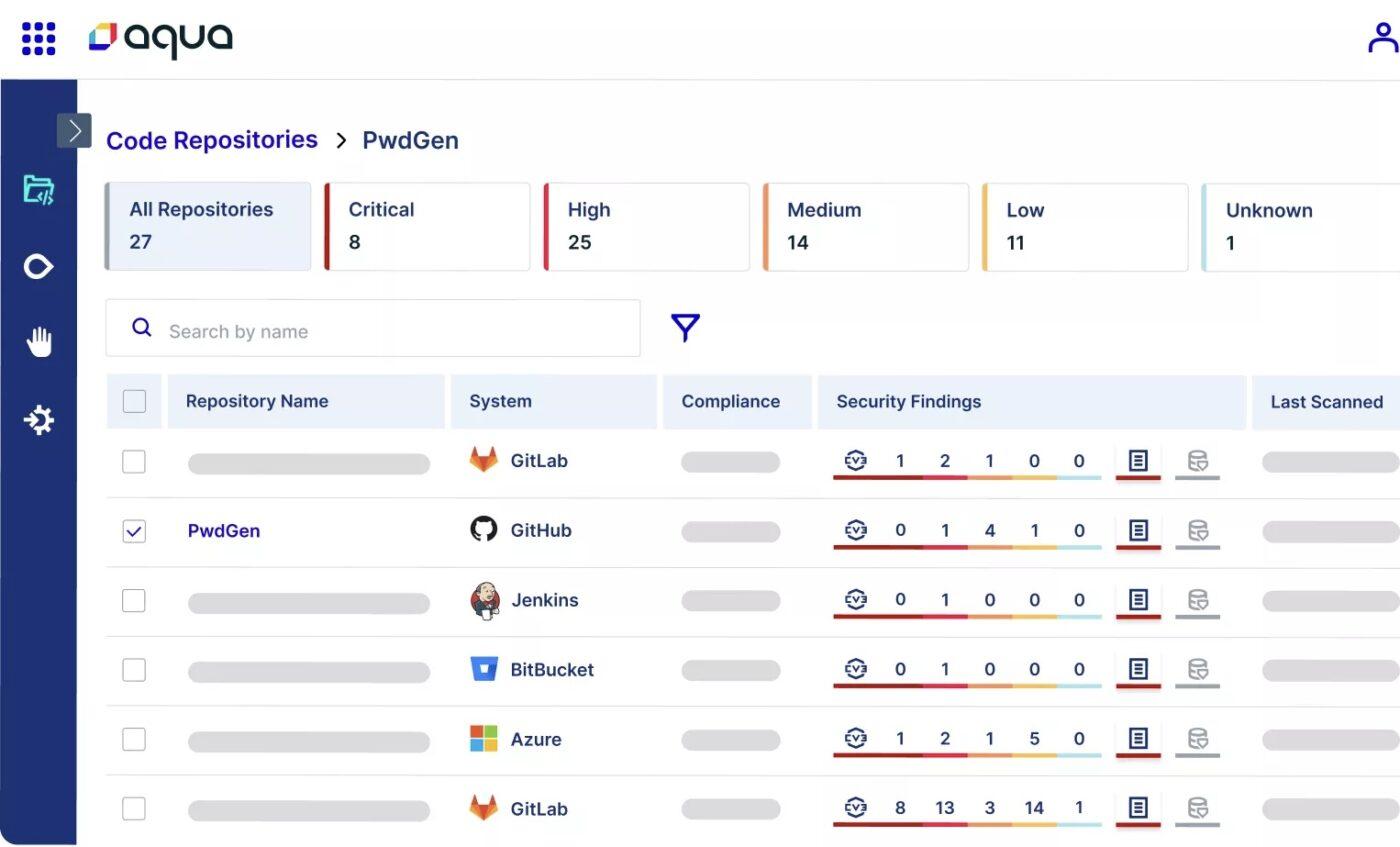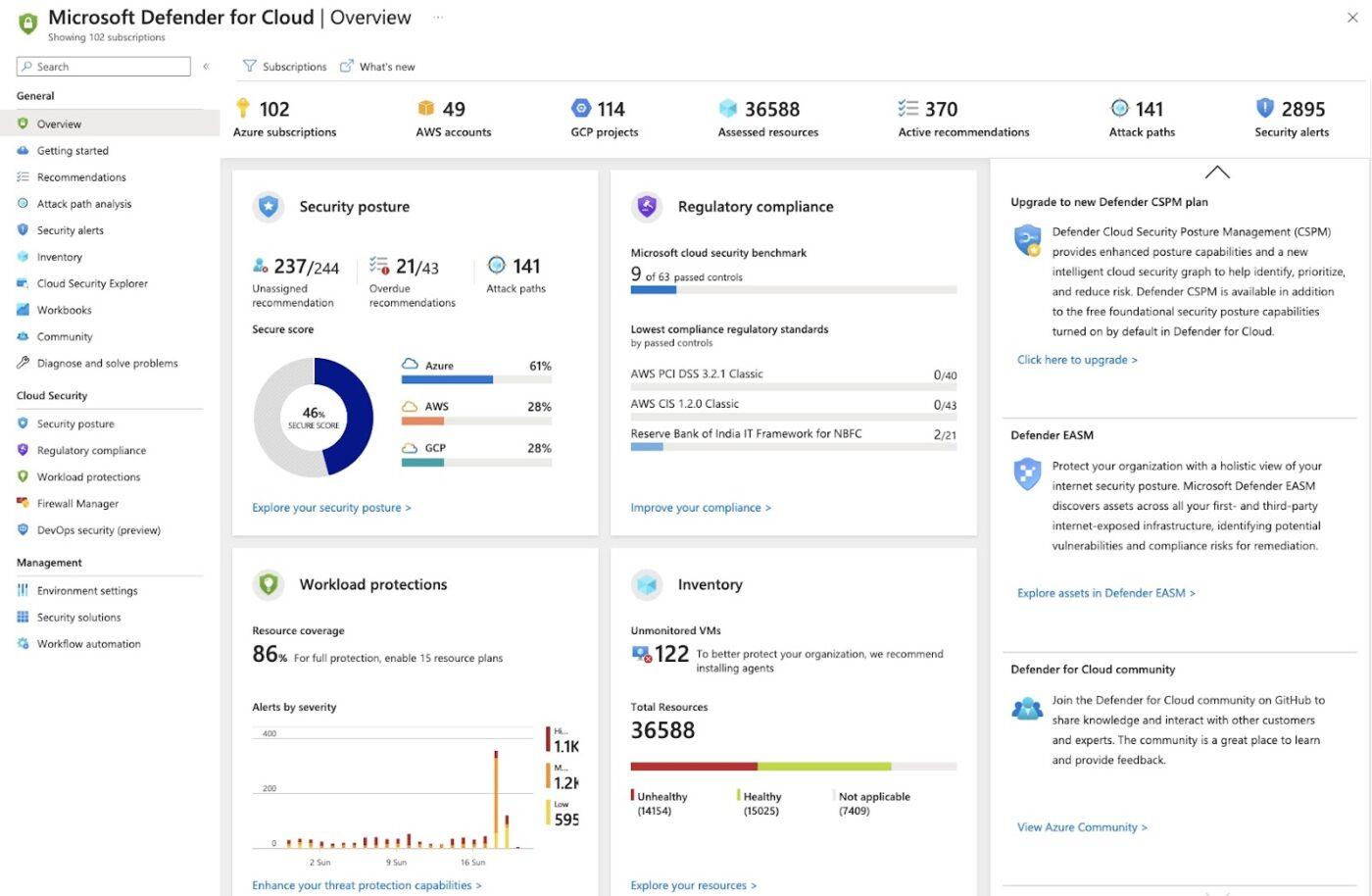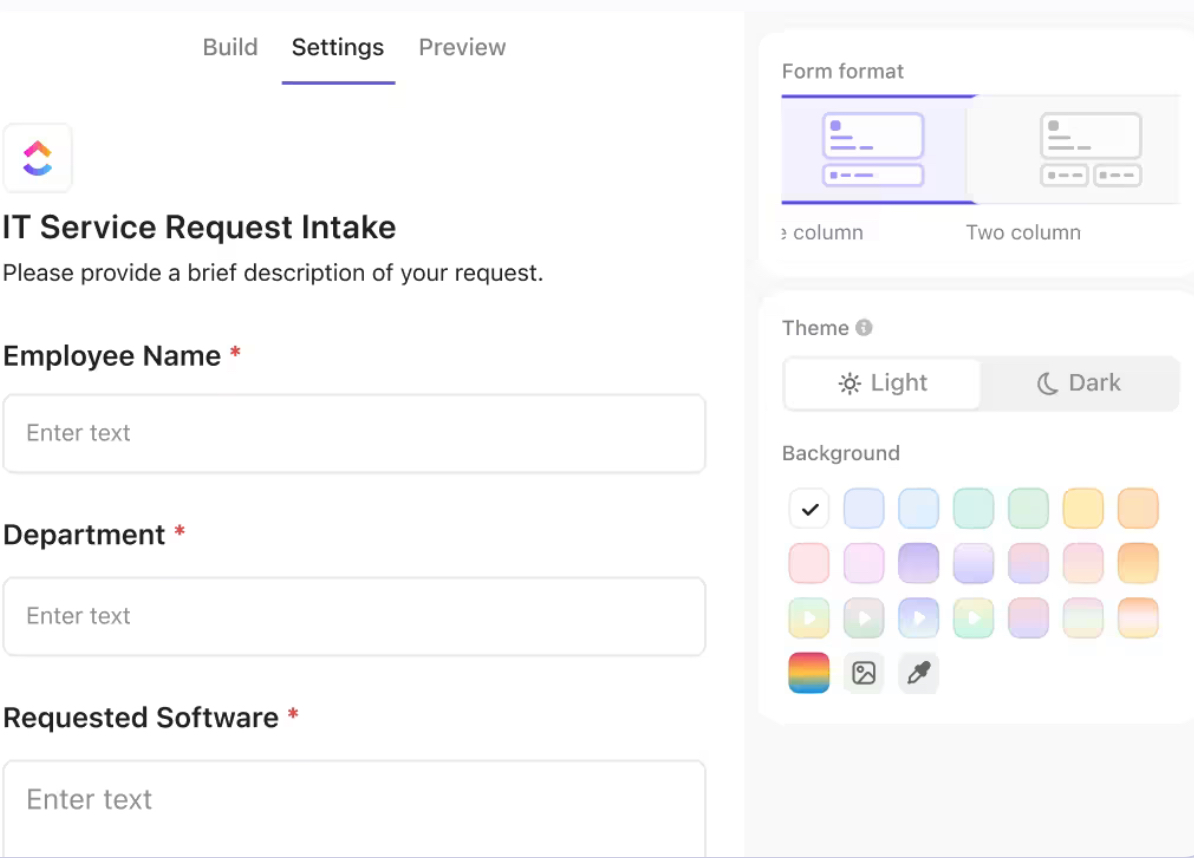Is Wiz giving you solid visibility but falling short on real-time remediation, host-level telemetry, or network traffic analysis?
Safe to say, you’re not the only one noticing the gaps.
As cloud environments become increasingly complex, security teams require tools that identify risks and help mitigate them.
This blog post breaks down some of the best Wiz competitors that fill in those missing pieces. Stick around till the end to see how ClickUp (yes, the productivity platform!) supports efficient cloud security collaboration. 🔐
- What Should You Look for in Wiz Competitors?
- Wiz Competitors at a Glance
- The 10 Best Wiz Competitors and Alternatives
- 1. Palo Alto Prisma Cloud (Best for end-to-end cloud security and DevSecOps integration)
- 2. Lacework (Best for cloud environments with compliance needs)
- 3. Orca Security (Best for rapid deployment across multi-cloud environments)
- 4. Tenable (Best for unified vulnerability scanning)
- 5. Aqua Security Software (Best for DevOps teams with container security needs)
- 6. Microsoft Defender for Cloud (Best for Microsoft-based cloud environments)
- 7. Qualys (Best for hybrid asset protection)
- 8. Check Point (Best for integrated security and posture management)
- 9. Sysdig (Best for Kubernetes-heavy DecSecOps operations)
- 10. Snyk (Best for shift-left security and developer-first workflows)
- Other Cloud Security Tools: ClickUp
What Should You Look for in Wiz Competitors?
When exploring the top alternatives to Wiz, start by identifying the specific gaps in your cybersecurity project management. The right solution will directly address those gaps and strengthen your overall security strategy. Here are some features to look out for:
- Agent‑based host telemetry: Seek Wiz competitors that deploy lightweight agents to capture process, file, and registry activity for richer forensics
- Automated remediation workflows: Prioritize platforms that integrate with ticketing systems and auto‑apply fixes or policy updates
- Network traffic analysis: Choose tools that embed continuous traffic inspection and anomaly detection across virtual private clouds (VPCs)
- Deception and honeypots: Evaluate solutions with native honeypot deployment to trap attackers and uncover lateral movement
- Advanced SBOM and supply-chain scanning: Consider providers that map full software bill-of-materials (SBOM) and flag upstream vulnerabilities
- Custom dashboard and reporting: Target Wiz alternatives with drag‑and‑drop widgets, personalized metrics, and white‑label reporting
- On‑premise and legacy support: Pick a vendor with both cloud and on‑premise agents for uniform coverage in hybrid or legacy environments
🧠 Fun Fact: In 2013, AWS signed a $600 million deal with the CIA, setting the stage for secure cloud adoption in the public sector. It was the beginning of the now-booming GovCloud ecosystem.
Wiz Competitors at a Glance
Here’s a table comparing all Wiz competitors and alternatives. 📊
| Tool | Best for | Best features | Pricing* |
| Palo Alto Prisma Cloud | End-to-end cloud security and DevSecOps for mid-market to enterprise organizations | Cloud Security Posture Management (CSPM), Cloud Workload Protection (CWPP), Cloud Infrastructure Entitlement Management (CIEM), AI-powered risk prioritization | Custom pricing |
| Lacework | Polygraph behavioral anomaly detection and full-stack visibility for mid-market to enterprise organizations | Behavior-based anomaly detection, risk prioritization, automated compliance checks | Custom pricing |
| Orca Security | Agentless vulnerability management for small to mid-sized businesses with multi-cloud environments | Context-rich prioritization, attack path visualization, SideScanning technology | Custom pricing |
| Tenable | Broad vulnerability management across cloud and on-premise environments for enterprises | CSPM, unified vulnerability scanning, Infrastructure as Code (IaC) security | Custom pricing |
| Aqua Security Software | Cloud-native full-lifecycle security for small- to medium-sized IT teams and DevOps teams with container security needs | Container and Kubernetes runtime protection, serverless workloads, CI/CD pipeline integration | Custom pricing |
| Microsoft Defender for Cloud | Security management for mid-sized companies on Microsoft-based cloud environments | Native CSPM and CWP with centralized alerts, built-in regulatory standards and reporting, Azure integration | Custom pricing |
| Qualys | Agent-based and agentless security scanning for enterprises and large developer teams | Hybrid asset protection (cloud + legacy), centralized reporting, CSPM for multi-cloud | Custom pricing |
| Check Point | Integrated security and posture management for mid-market companies and enterprises | CSPM, cloud-native threat prevention, serverless security, third-party API support | Custom pricing |
| Sysdig | Kubernetes-heavy DevSecOps operations for small to mid-market companies | Incident forensics with eBPF, real-time threat detection, vulnerability prioritization | Custom pricing |
| Snyk | Dev-first security for code, containers, and IaC for large developer teams and enterprises | Shift-left security, developer-first workflows, CI/CD integration, | Free plan available; Paid plans start at $25/month |
The 10 Best Wiz Competitors and Alternatives
Now, let’s dive deeper into the best Wiz competitors. 👇
How we review software at ClickUp
Our editorial team follows a transparent, research-backed, and vendor-neutral process, so you can trust that our recommendations are based on real product value.
Here’s a detailed rundown of how we review software at ClickUp.
1. Palo Alto Prisma Cloud (Best for end-to-end cloud security and DevSecOps integration)
Prisma Cloud in Palo Alto Networks is a comprehensive Cloud-Native Application Protection Platform (CNAPP) designed to protect applications throughout their lifecycle, from code to cloud.
Using a combination of machine learning, advanced analytics, and Precision AI, it continuously scans infrastructure, application code, and workloads to detect misconfigurations, policy violations, and active threats.
It also integrates with Palo Alto’s broader security ecosystem, including Cortex XDR and WildFire, making building a unified security strategy easier.
Palo Alto Prisma Cloud best features
- Secure infrastructure across providers using cloud security posture management (CSPM) to detect misconfigurations, drift, and policy violations
- Protect workloads and containers with cloud workload protection (CWP), including agentless scanning for VMs, serverless, and Kubernetes environments
- Harden your CI/CD pipelines through integrated code security, IaC scanning, software composition analysis, and secrets detection before runtime
- Gain deep visibility and control over assets in multi-cloud and hybrid environments
Palo Alto Prisma Cloud limitations
- It involves a complex and time-consuming initial setup, especially without prior experience with Palo Alto tools
- Documentation gaps, particularly for advanced use cases and real-world deployment examples
Palo Alto Prisma Cloud pricing
- Custom pricing
Palo Alto Prisma Cloud ratings and reviews
- G2: 4.4/5 (390+ reviews)
- Capterra: Not enough reviews
What are real-life users saying about Palo Alto Prisma Cloud?
Here’s what a G2 review had to say about this Wiz competitor:
🔍 Did You Know? In the early 1990s, websites were mostly HTTP. It wasn’t until 1994 that Netscape introduced HTTPS to encrypt browser traffic, prompting the earliest conversations around web security.
2. Lacework (Best for cloud environments with compliance needs)
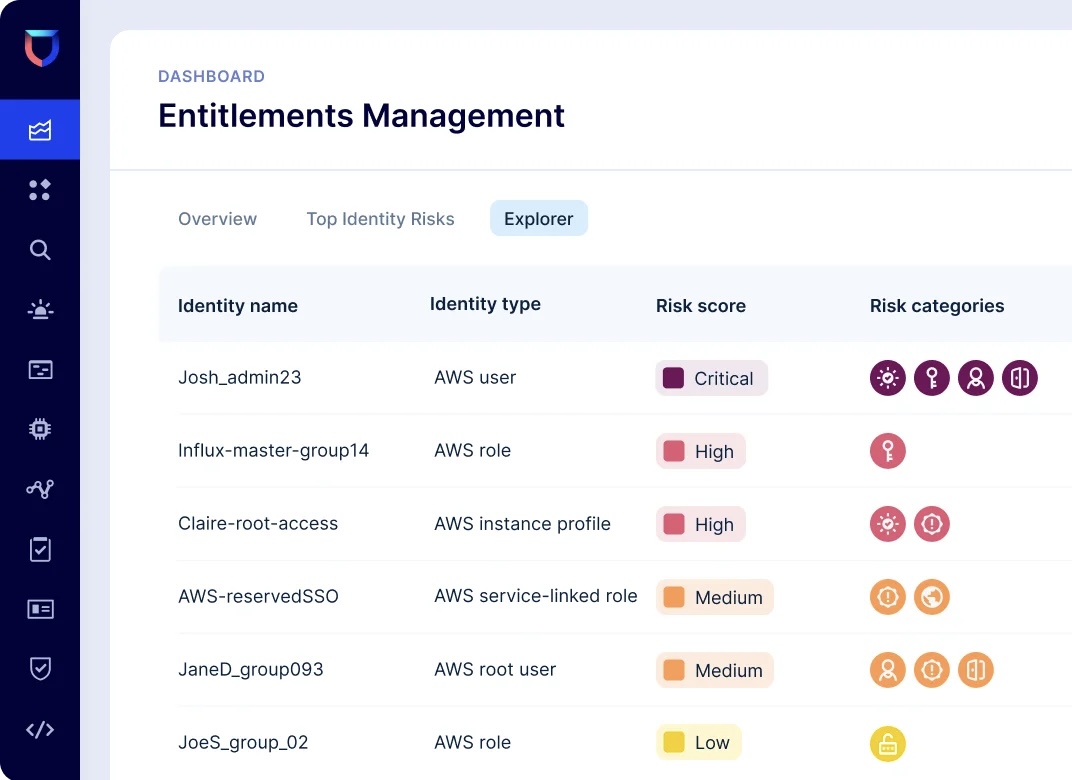
Lacework FortiCNAPP helps teams connect cloud risk signals with real-time threat detection, whether analyzing misconfigurations or determining how to securely store client information. It creates a seamless view of vulnerabilities, misconfigurations, and active threats across your entire cloud environment.
With native support across AWS, Azure, and Google Cloud, the platform continuously analyzes activity to surface early signs of ransomware, cryptojacking, and compromised credentials.
Lacework best features
- Detect zero-day attacks early with the Polygraph® Data Platform that reveals behavioral anomalies and threat patterns
- Uncover identity risks with CIEM that scores permissions and flags over-privileged roles across clouds
- Simplify remediation with automated insights into misconfigurations, vulnerabilities, and policy violations
- Shift left with integrated IaC Security, SAST, and software composition analysis (SCA) to catch issues before deployment
- Automate compliance checks and reporting for various industry standards
Lacework limitations
- Lacks real-time remediation tracking; closed issues take 24+ hours to disappear
- Users find alert configuration to be difficult, and desire better integrations with Slack, Datadog, SIEM tools, and ticket platforms
Lacework pricing
- Custom pricing
Lacework ratings and reviews
- G2: 4.4/5 (380+ reviews)
- Capterra: Not enough reviews
📮 ClickUp Insight: 74% of employees use two or more tools just to find the information they need—while jumping between emails, chat, notes, project management tools, and documentation. This constant context-switching wastes time and slows down productivity. As the everything app for work, ClickUp unifies all your work—email, chat, docs, tasks, and notes—into a single, searchable workspace, so everything is exactly where you need it.
3. Orca Security (Best for rapid deployment across multi-cloud environments)
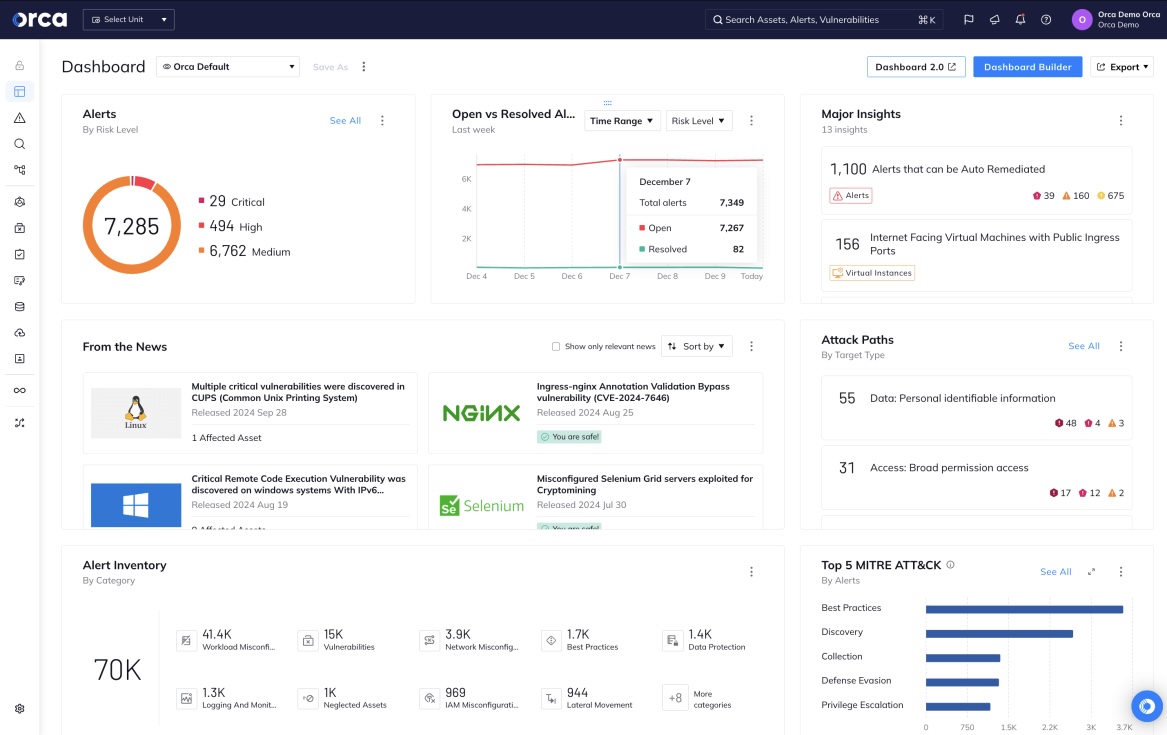
Orca Security gives teams deep visibility into every layer of their cloud environment without the overhead of installing agents. It automatically correlates risks, such as misconfigurations, exposed APIs, identity issues, and vulnerabilities, to surface the most critical threats.
This tool combines real-time telemetry, professional communication, advanced risk prioritization, and broad compliance support into a single interface.
Its focus on ‘toxic combinations’ helps teams prioritize the 1% of alerts that truly matter, cutting through the noise often associated with cloud security tools.
Orca Security best features
- Deploy agentless scanning with SideScanning™ to gain instant visibility into workloads, risks, and configurations
- Activate the Orca Sensor for runtime protection, enabling real-time detection and investigation using lightweight, kernel-level observability
- Enforce compliance at scale using over 100 out-of-the-box regulatory frameworks, including CIS Benchmarks, PCI DSS, HIPAA, and SOC 2
- Reduce operational overhead and performance impact on production environments
Orca Security limitations
- Agentless scanning may miss deeper runtime insights compared to agent-based Wiz competitors
- Lacks robust shift-left capabilities. No known IDE/CLI integrations for developer workflows
Orca Security pricing
- Custom pricing
Orca Security ratings and reviews
- G2: 4.6/5 (200+ reviews)
- Capterra: 4.8/5 (50+ reviews)
What are real-life users saying about Orca Security?
A user shared this review on Capterra:
🧠 Fun Fact: The concept of ‘zero trust’ came from Forrester analyst John Kindervag, who suggested organizations should never trust any network by default. It took over a decade (and some painful breaches) for the idea to go mainstream.
4. Tenable (Best for unified vulnerability scanning)
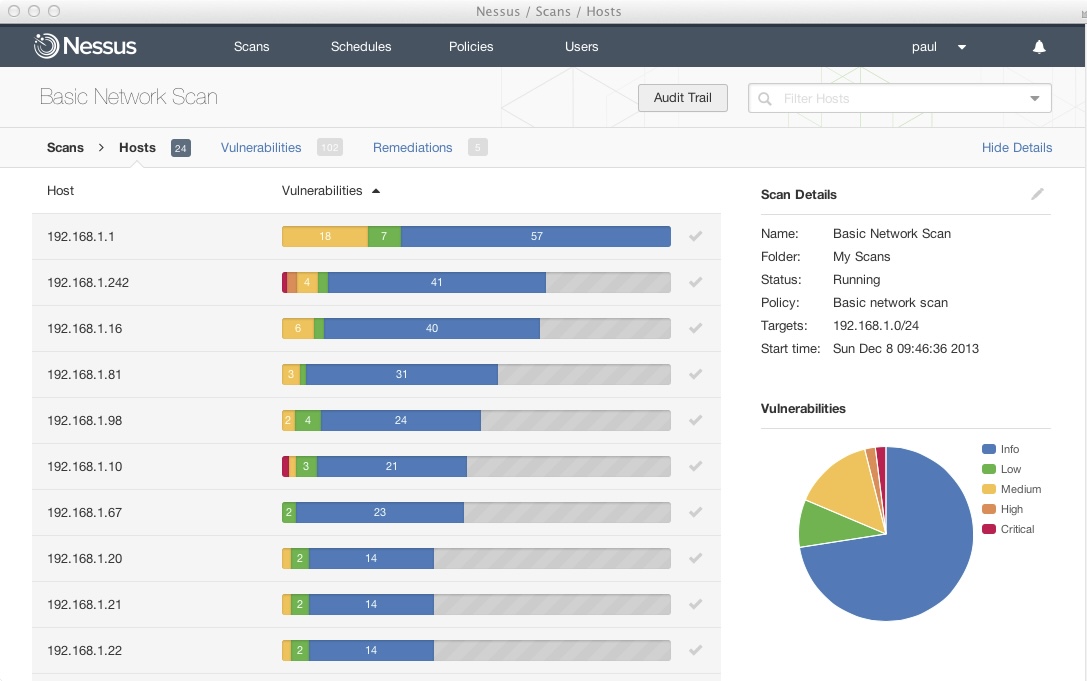
Tenable brings a consolidated approach to securing hybrid and multi-cloud environments through its flagship exposure management platform, Tenable One. Instead of treating vulnerabilities, misconfigurations, and identity issues as isolated problems, Tenable connects the dots to provide a prioritized view of risks across your entire attack surface.
It supports FedRAMP-authorized solutions, making it a trusted choice for government and highly regulated environments. The tool also features capabilities such as just-in-time (JIT) access, autonomous patching, and AI-layered analytics.
Tenable best features
- Close identity gaps with Tenable Identity Exposure, detecting misconfigurations and risky access across Active Directory and Entra ID
- Accelerate remediation through Tenable Patch Management, which automatically matches vulnerabilities to the right patches and executes autonomous patching
- Enforce least privilege using Tenable CIEM and JIT access to restrict unnecessary cloud permissions
- Integrate security checks seamlessly into the DevOps lifecycle
Tenable limitations
- No built-in way to automatically purge historical scan results, which eats up disk space
- While strong in vulnerability and posture management, its runtime protection features may be less mature than those of specialized CNAPP providers
- It occasionally flags non-critical issues, increasing the workload for security teams
Tenable pricing
- Custom pricing
Tenable ratings and reviews
- G2: 4.5/5 (250+ reviews)
- Capterra: Not enough reviews
5. Aqua Security Software (Best for DevOps teams with container security needs)
Aqua Security helps secure modern applications across their entire lifecycle, from development and deployment to runtime. Its real-time controls and shift-left scanning empower security teams to catch vulnerabilities early and respond quickly to active threats without slowing down agile development pipelines.
This Wiz alternative uses a combination of agentless and agent-based methods to provide flexibility in deployment and coverage. It enables the unification of code, infrastructure, and workload security across hybrid and multi-cloud environments.
Aqua Security Software best features
- Use Universal Code Scanning to detect vulnerabilities, secrets, IaC misconfigurations, and malware across all source code and registries
- Establish Acceptance Gates to enforce assurance policies tailored to different pipelines, stopping non-compliant workloads before production
- Apply Kubernetes Assurance Policies to enforce runtime controls using the open policy agent (OPA) and Rego rules for security governance
Aqua Security Software limitations
- Lacks support for scanning certain artifact types like Maven and npm packages
- Limited API capabilities, especially for image search and automation use cases
Aqua Security Software pricing
- Custom pricing
Aqua Security Software ratings and reviews
- G2: 4.2/5 (50+ reviews)
- Capterra: Not enough reviews
What are real-life users saying about Aqua Security Software?
Here’s a quick snippet from a real user:
🧠 Fun Fact: Though the concept existed before, Google CEO Eric Schmidt used the phrase ‘cloud computing’ at a 2006 conference. It took off from there (and so did the security concerns).
6. Microsoft Defender for Cloud (Best for Microsoft-based cloud environments)
Microsoft Defender for Cloud combines security posture management, workload protection, and DevSecOps capabilities.
Through Microsoft Defender Extended Detection and Response (XDR), organizations can connect insights from cloud infrastructure with alerts from endpoints and user identities, building a broader threat picture.
Its Secure Score feature gives organizations a clear metric to track and improve their overall security posture over time. You can also model potential attack paths with Cloud Security Explorer and implement governance rules across business units.
Microsoft Defender best features
- Leverage seamless, native integration with the Microsoft Azure platform
- Identify lateral movement paths and weak spots using Attack Path Analysis and the interactive Cloud Security Explorer
- Protect hybrid and multicloud workloads by applying Defender for Servers, Containers, and Storage to secure infrastructure, data, and applications
- Leverage Microsoft Entra Permissions Management to detect and remediate excessive permissions across users, apps, and services in any cloud
- Correlate and act on threats fast with SIEM and security orchestration, AI workflow automations, and response (SOAR) tools to reduce time-to-remediation
Microsoft Defender limitations
- Users frequently report alert fatigue due to excessive notifications and false positives
- This Wiz competitor struggles to detect zero-day attacks or malware with hidden signatures, limiting trust in critical threat scenarios
- The pricing and licensing model can be complex to navigate and forecast, particularly in multi-cloud deployments
Microsoft Defender pricing
- Custom pricing
Microsoft Defender ratings and reviews
- G2: 4.4/5 (300+ reviews)
- Capterra: Not enough reviews
🔍 Did You Know? One of the earliest DevSecOps wins came from Netflix’s open-source tools. Netflix released Security Monkey and Stethoscope back in the 2010s, pioneering the idea of building security into CI/CD pipelines and influencing the future of automated CSPM tools and Wiz competitors.
7. Qualys (Best for hybrid asset protection)
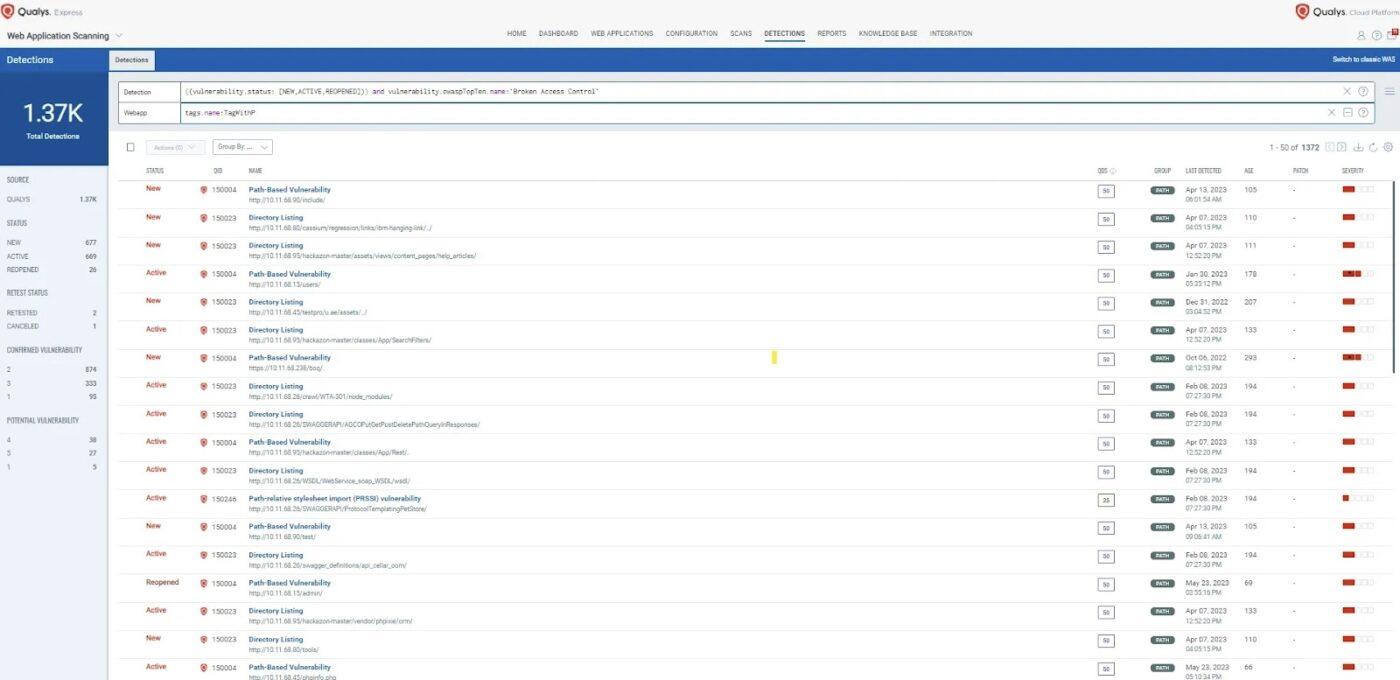
Qualys delivers a unified approach to cybersecurity with its Enterprise TruRisk™ Platform, combining asset visibility, vulnerability management, compliance, and remediation into one seamless system. The Wiz competitor offers high-speed telemetry and intelligent correlation across billions of data points.
The platform utilizes lightweight Cloud Agents and agentless scanners to provide comprehensive visibility and security assessment of cloud workloads, containers, and infrastructure. With the introduction of Qualys TotalCloud, its CNAPP and TotalAppSec for application risk, Qualys extends protection across the whole stack.
The platform supports IaC security, Kubernetes runtime protection, and even LLM safety for GenAI deployments.
Qualys best features
- Consolidate numerous security and compliance functions onto a single platform
- Use TruRisk Eliminate™ to remediate critical vulnerabilities like CISA KEVs and ransomware exposures through patching, isolation, or mitigation workflows
- Continuously scan IaC templates for misconfigurations and monitor SaaS apps for privilege misuse and compliance issues
- Streamline response with Qualys Flow and build automated remediation workflows using a no-code/low-code engine
Qualys limitations
- The dashboard is not intuitive, making navigation and task execution harder for new users
- While detection is strong, patch deployment and remediation features aren’t as seamless or efficient as those of other Wiz competitors
- Managing the full suite of integrated applications can require a significant investment in training and configuration
Qualys pricing
- Custom pricing
Qualys ratings and reviews
- G2: 4.3/5 (240+ reviews)
- Capterra: 4/5 (30+ reviews)
What are real-life users saying about Qualys?
One Capterra review puts it this way:
8. Check Point (Best for integrated security and posture management)
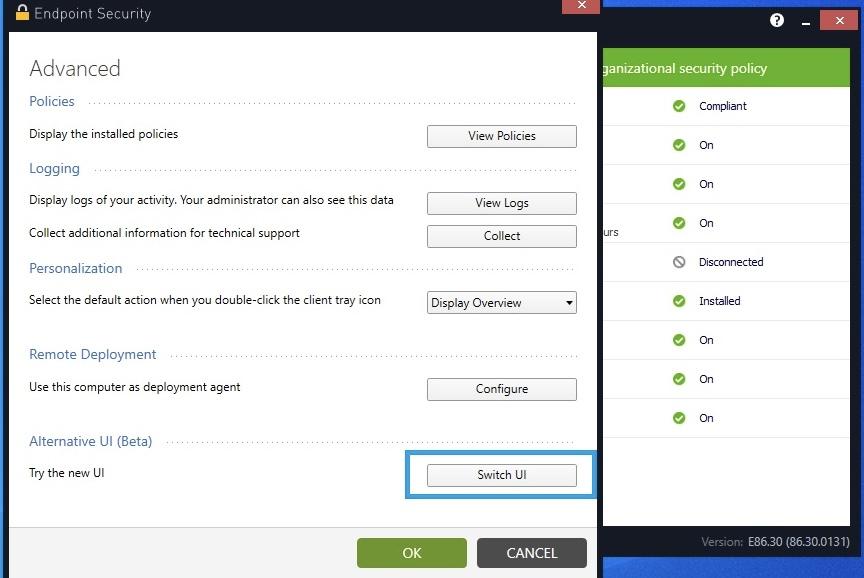
Check Point’s flagship Quantum Security Gateways and CloudGuard solutions are designed to provide deep protection across networks, workloads, and remote access points.
For endpoint protection, Harmony Endpoint delivers EPP (Endpoint Protection Platform), EDR (Endpoint Detection and Response), and XDR (Extended Detection and Response) in a single lightweight client, offering comprehensive visibility and control from the edge to the cloud.
It allows teams to apply consistent security policies and protect against sophisticated cyberattacks across their entire cloud footprint, from infrastructure to applications.
Check Point best features
- Implement 60+ machine learning engines and global threat intelligence to detect and block advanced attacks, including zero-day exploits
- Manage users, apps, devices, and cloud networks under a single centralized console with granular rule enforcement
- Protect remote workforces with Harmony SASE to deliver per-application access, device posture checks, and Zero Trust policies with full mesh connectivity
- Easily connect with SOC software and automate threat mitigation using extensive third-party API support
Check Point limitations
- Configuration can be time-consuming, especially for small teams without dedicated IT staff
- Full scans and sandboxing can slow down performance, particularly on low-spec machines
Check Point pricing
- Custom pricing
Check Point ratings and reviews
- G2: 4.5/5 (200+ reviews)
- Capterra: Not enough reviews
9. Sysdig (Best for Kubernetes-heavy DecSecOps operations)
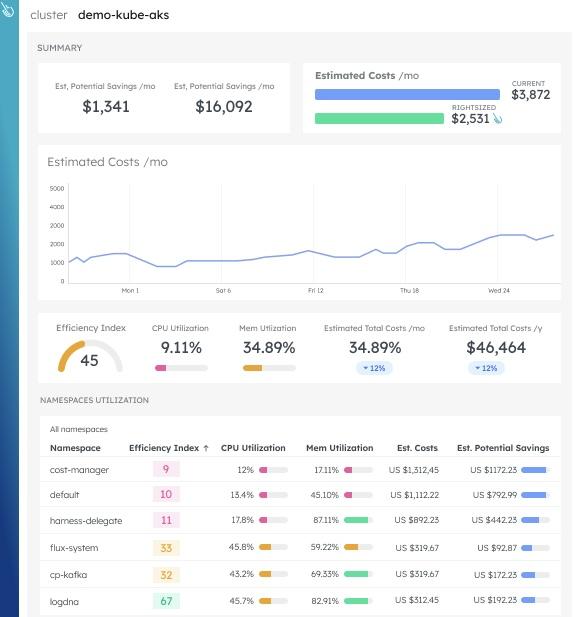
Sysdig is a cloud-native application protection platform designed for teams that prioritize real-time detection, contextual risk insights, and deep runtime visibility, while enforcing robust data security measures.
Its multi-cloud support and managed Prometheus monitoring help it deliver end-to-end visibility across your infrastructure without context switching.
By combining security, compliance, and performance monitoring, Sysdig helps teams understand the full context of an incident. Its key differentiator is the ability to prioritize vulnerabilities based on whether the vulnerable package is actually in use at runtime, allowing teams to focus their remediation efforts
Sysdig best features
- Focus on actively exploited or reachable risks instead of static Common Vulnerabilities and Exposures (CVE) lists
- Uncover suspicious behavior with cloud-native detection that leverages live system data and behavioral context
- Reduce custom metric costs and eliminate underused resources using Sysdig Monitor’s detailed utilization tracking
- Accelerate incident response with detailed forensics and audit trails
Sysdig limitations
- Lateral movement detection in CSPM scenarios, particularly in AWS environments, is limited
- On-premise deployments can demand substantial storage resources
- Its primary strength is in runtime security and containers; other areas of its CNAPP offering may be less developed than competitors
Sysdig pricing
- Custom pricing
Sysdig ratings and reviews
- G2: 4.7/5 (100+ reviews)
- Capterra: Not enough reviews
What are real-life users saying about Sysdig?
A G2 review summed it up like this:
🧠 Fun Fact: According to IBM’s Cost of a Data Breach Report 2024, organizations that extensively implemented security AI and automation saved an average of $2.2 million in breach-related costs compared to those that did not.
10. Snyk (Best for shift-left security and developer-first workflows)
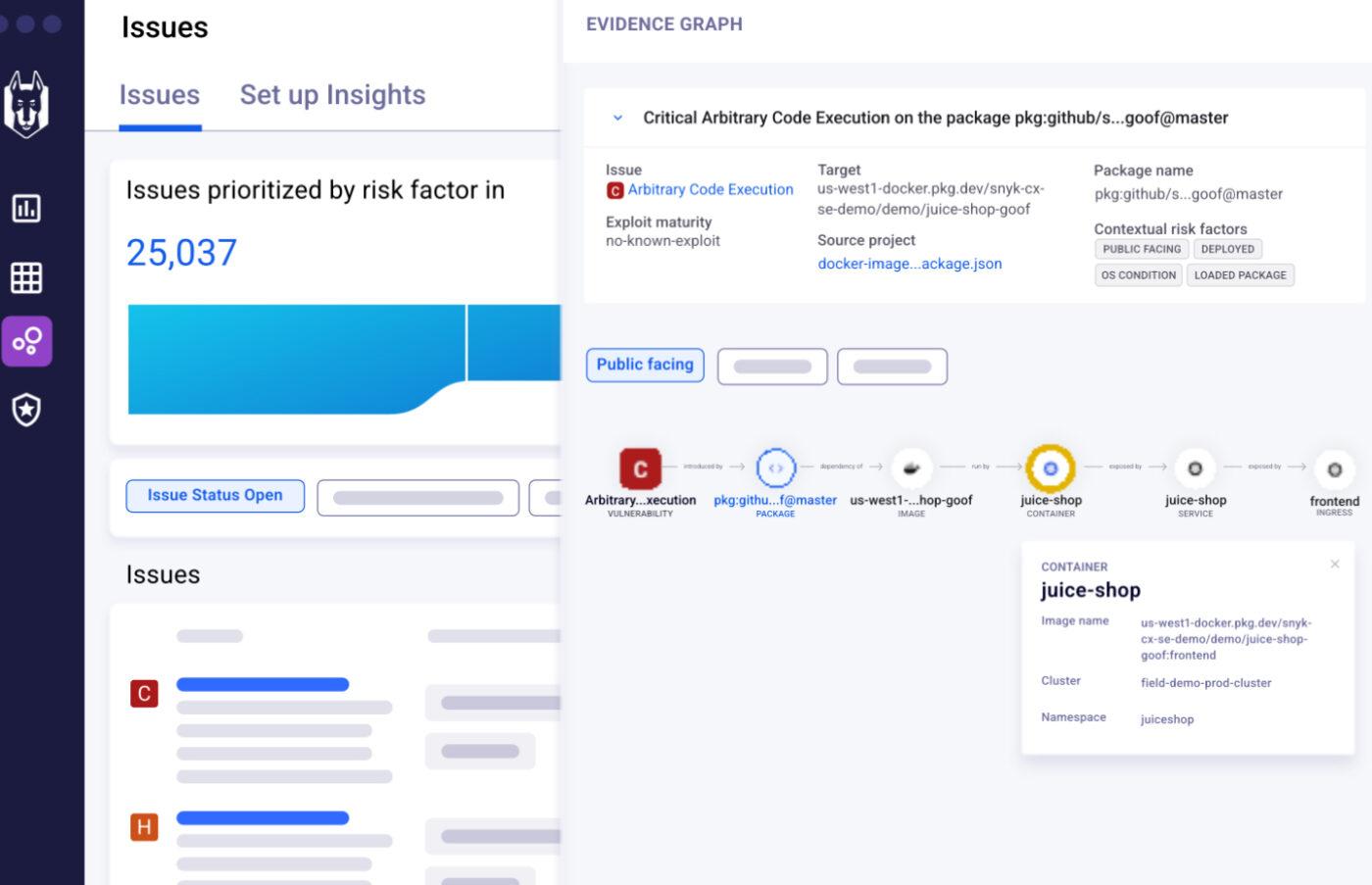
via Snyk
Snyk is a developer-focused security platform with a modern approach to application security that fits seamlessly into fast-paced, cloud-native development workflows.
It stands out with its AI-powered security platform that detects and remediates vulnerabilities across the entire software development lifecycle. The Wiz alternative’s core engine, DeepCode AI, drives smart, explainable remediation and helps teams stay ahead of potential risks introduced by GenAI tools and open source libraries.
Snyk best features
- Find and fix configuration drift across cloud environments with Snyk IaC security, providing inline remediation directly in your development tools
- Automate open source risk management with one-click pull requests, real-time monitoring, and license compliance checks
- Integrate security seamlessly into existing developer tools and workflows
- Correlate risks with business context using Snyk AppRisk to prioritize high-impact vulnerabilities and track AppSec coverage
Snyk limitations
- Lacks on-premises deployment options, limiting flexibility for organizations with strict infrastructure policies
- The tool generates incomplete SBOM data through the CLI, forcing users to rely on third-party tools or other Wiz competitors
Snyk pricing
- Free
- Team: $25/month per user
- Enterprise: Custom pricing
Snyk ratings and reviews
- G2: 4.5/5 (120+ reviews)
- Capterra: 4.6/5 (20+ reviews)
🔍 Did You Know? In 2019, a misconfigured firewall in Capital One’s AWS setup let a former AWS employee access over 100 million customer records. The root cause? A server-side request forgery (SSRF) vulnerability, something Wiz competitors specifically flag now.
Other Cloud Security Tools: ClickUp
Identifying risks with Wiz competitors is just the first step. The bigger challenge lies in what comes after: organizing the response, assigning tasks to the right teams, and tracking progress.
That’s where ClickUp steps in, not as a security scanner, but as a command center for orchestrating everything that happens after the scan. At its core is the ClickUp Project Management Software, which offers a centralized platform for planning remediation efforts, monitoring progress, managing documentation, and communicating in real time.
For IT and security teams operating at scale, ClickUp’s IT and PMO Solution enables PMO teams to standardize service request intake, automate SLA-driven escalations, and provide visibility into resource utilization across portfolios with enterprise-grade controls.
Let’s look at how ClickUp complements Wiz competitors throughout the operational lifecycle. 🔄
Turn alerts into tasks
Once issues are flagged, they need to be brought into an actionable workflow.
ClickUp Forms makes each vulnerability actionable by turning it into a task in ClickUp Tasks, complete with details about severity, affected systems, and target dates. This ensures consistent metadata capture for tracking and prioritization.
Once issues are in the pipeline, ClickUp Multiple Assignees and ClickUp Custom Fields make it easy to assign, organize, and track remediation from start to finish.
📌 Example: The security team fills out a form to submit an issue, automatically creating a task in ClickUp with predefined Custom Fields like ‘Network’ or ‘Compliance’. Even better? Both the network engineer and the compliance officer can be assigned to work on the task at once.
Cut the manual work
ClickUp Automations adds another layer of efficiency. Tasks can be auto-assigned based on severity, escalated if idle, or moved through workflows without manual handoffs using ClickUp’s intuitive if‑then builder.
A few workflow automation examples include:
- Auto-assigning tasks when a vulnerability is opened
- Triggering reminders before due dates
- Escalating unresolved incidents to stakeholders
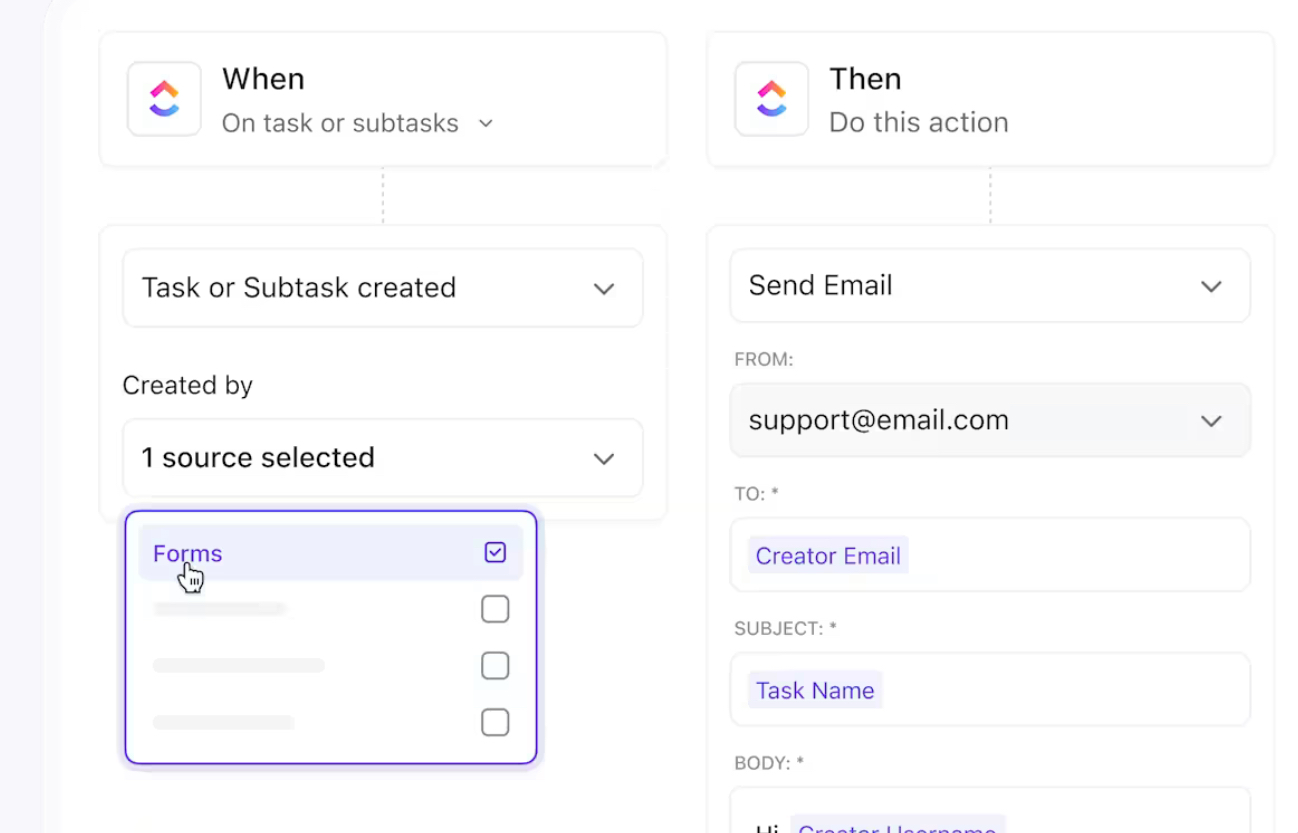
📌 Example: When a critical vulnerability is detected, an automation can instantly assign the task to the security lead based on its severity, apply the correct priority, and set a due date. If the task remains unresolved after 48 hours, it can automatically escalate to the CISO.
Chat where you work
When remediation starts, updates can fly in from every direction.
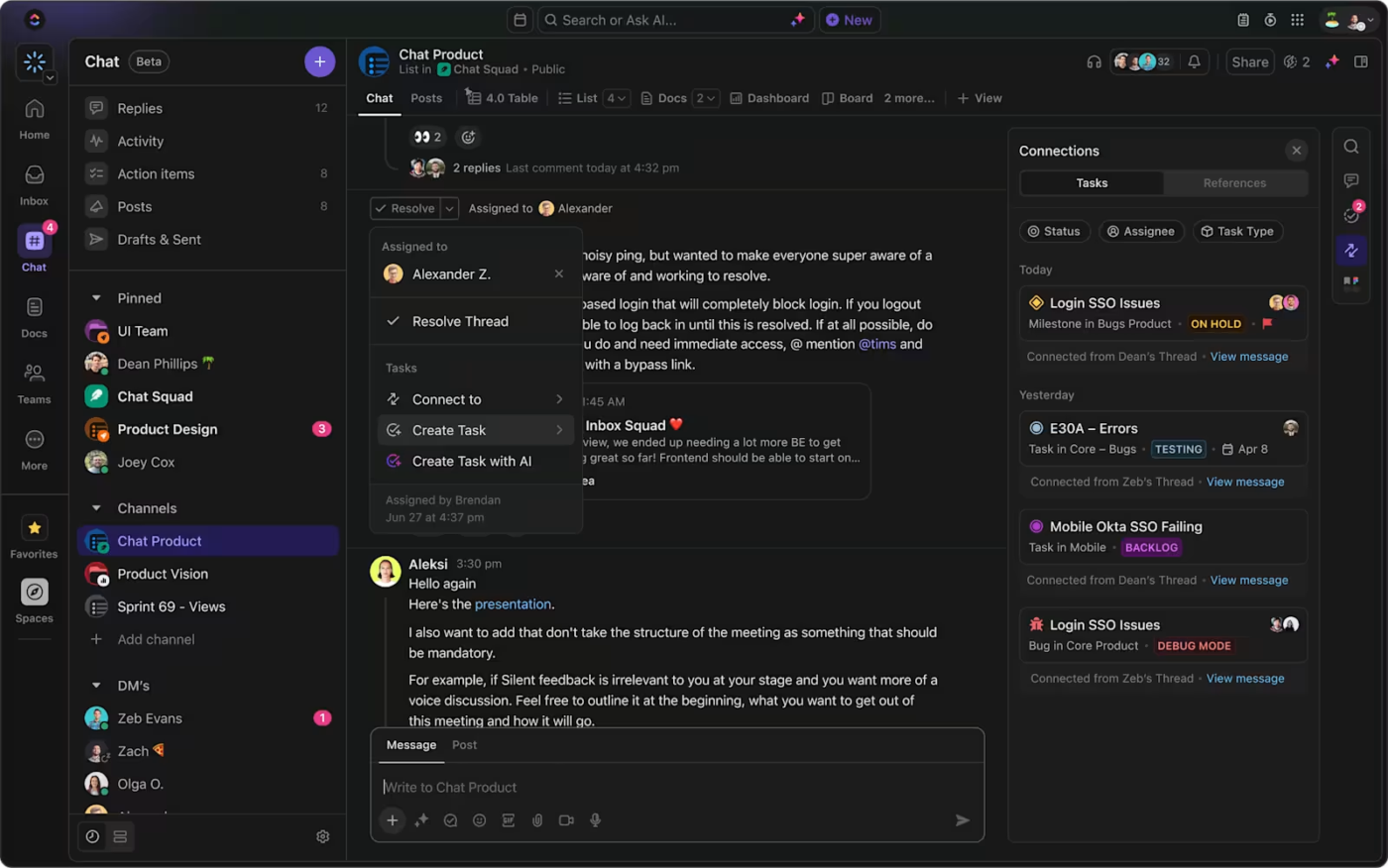
ClickUp Chat keeps those conversations right where the work happens—alongside tasks, docs, and timelines. Conversations can be converted into Tasks with a click, tagged appropriately, and maintained in full context to keep audit logs intact.
📌 Example: Let’s say a high-risk vulnerability is flagged and a fix is in progress. The security lead drops a quick update in the project chat, tags the engineer, and links the task directly in the message.
If the fix requires follow-up, that message can be converted into a new task instantly, carrying over the assignee, deadline, and any files shared in the secure collaboration tool.
Let AI handle the busywork
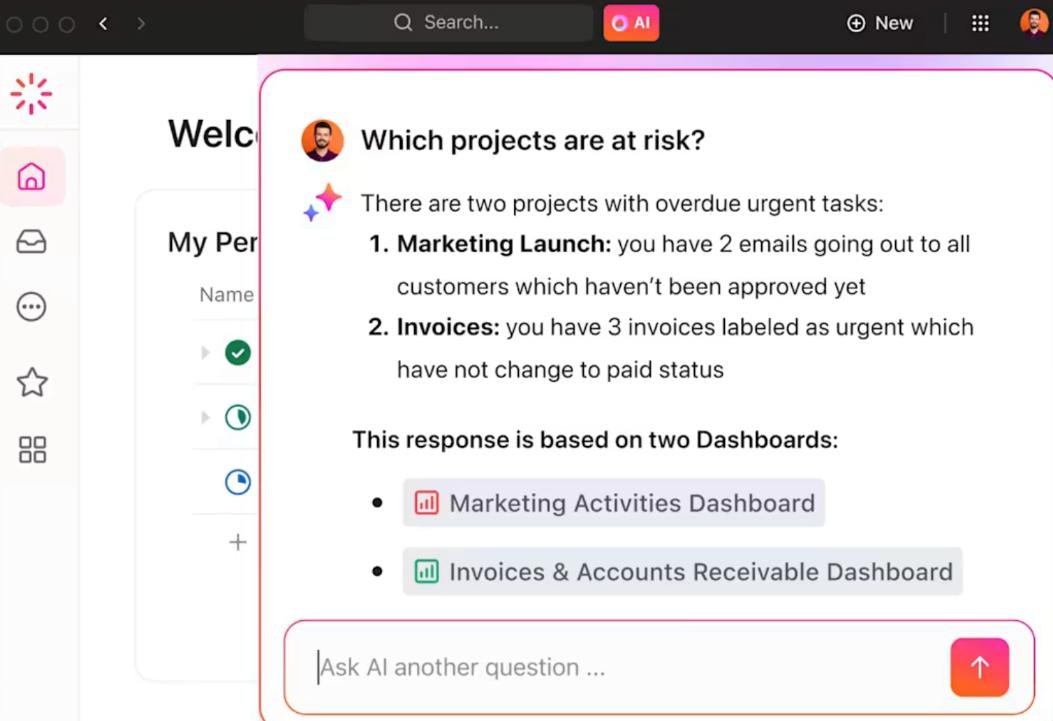
ClickUp Brain, your AI-powered assistant, uses ongoing task activity, comments, docs, and chat history to deliver actionable insights. It helps by:
- Summarizing remediation threads into concise status updates or stakeholder reports
- Generating automatic follow-up tasks from chat or doc discussions
- Drafting meeting summaries and action lists without manual note-taking
- Answering contextual questions, like ‘Which fixes are still pending for high-severity alerts?’
ClickUp best features
- Store and link cloud security documents: Keep your SOPs, compliance checklists, and incident logs in ClickUp Docs, linked to relevant tasks and timelines
- Record and summarize meetings: Capture decisions and action items from live meetings, with ClickUp AI Notetaker
- Track security tickets across 15+ project views: Utilize ClickUp Views to manage audits, service requests, and internal vulnerability assessments with List, Board, Gantt, Calendar, and more
- Visualize IT performance: Leverage 50+ cards in ClickUp Dashboards to monitor budgets, timelines, staffing, and completion rates across your security portfolio
- Standardize repeatable security workflows: Kickstart projects with project management templates for IT service management, penetration test planning, or policy reviews
- Assign responsibilities with role-based permissions: Control who can view, edit, or execute sensitive security tasks and workflows
- Activate AI Agents for hands-off support: Let ClickUp AI Agents surface unresolved issues, answer questions, and create tasks automatically to keep remediation moving
ClickUp pricing
ClickUp ratings and reviews
- G2: 4.7/5 (10,400+ reviews)
- Capterra: 4.6/5 (4,300+ reviews)
What are real-life users saying about ClickUp?
This G2 review really says it all:
📮 ClickUp Insight: 30% of workers believe automation could save them 1-2 hours per week, while 19% estimate it could unlock 3–5 hours for deep, focused work.
Even those small time savings add up: just two hours reclaimed weekly equals over 100 hours annually—time that could be dedicated to creativity, strategic thinking, or personal growth.💯
With ClickUp’s AI Agents and ClickUp Brain, you can automate workflows, generate project updates, and transform your meeting notes into actionable next steps—all within the same platform. No need for extra tools or integrations—ClickUp brings everything you need to automate and optimize your workday in one place.
💫 Real Results: RevPartners slashed 50% of their SaaS costs by consolidating three tools into ClickUp—getting a unified platform with more features, tighter collaboration, and a single source of truth that’s easier to manage and scale.
Finding the Right Fit Beyond Wiz
Whether you’re looking for stronger runtime protection, more actionable threat intel, or better compliance support, the Wiz competitors we explored each offer a distinct edge.
But here’s the bigger picture: comprehensive cloud security doesn’t live in isolation. You need a reliable solution to keep teams aligned, activities visible, and data accessible. That’s where ClickUp stands out.
As the everything app for work, it helps security teams align projects, processes, and people in one place. From managing remediation workflows and audits to automating tasks and leveraging AI through ClickUp Brain, it’s built to bring order to even the most complex environments.
Why wait? Sign up to ClickUp for free today!

